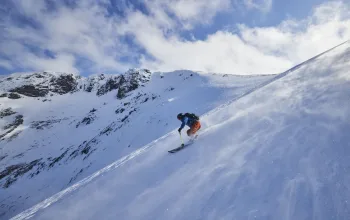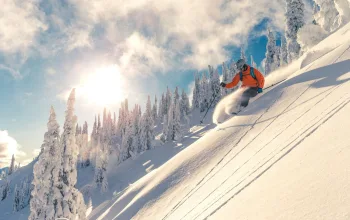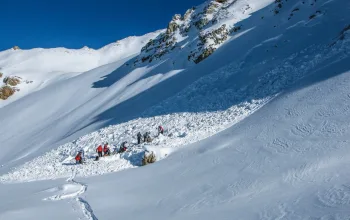Sponsored Content
If you love to ski, working as a ski instructor is pretty much a dream job. A life spent in the mountains, no commuting, doing what you love day in day out and getting paid to do something that most people pay lots of money to do as a holiday, what’s not to like?
Real jobs
The reality is somewhat different: yes it can be a fantastic job but of course it is seasonal (unless you fancy an endless winter swapping hemispheres each June and October), plus you need to remain physically fit or you can’t work, and you have to accept that on a powder day you might be teaching the beginner group who won’t venture away from the nursery slope.
However, if you love the idea of passing on your passion for skiing or snowboarding, there is nothing more satisfying than watching your students master their first linked turns and see their reaction as they first realise quite how much fun these sports can be. In terms of job satisfaction, and work/life balance, teaching snowsports is about as good as it gets.
You can even do it part time
Although many do choose a full-time career as a ski instructor, you don’t have to give up everything else to be one. Many ski instructors work in the busy weeks, Christmas, New Year, and Half-Term, or work in the UK at artificial slope ski centres like Skiplex alongside their day job.
Routes to qualification
There are a number of different qualifications from different national training bodies. In the UK the majority of instructors train with BASI – The British Association of Snowsports Instructors, who grade instructors from the entry level grade 1, to the International Ski Teacher Diploma ISTD – holders of which pretty much have their pick of jobs in any resort worldwide. Anyone completing BASI level 3 is awarded the International Ski Instructors Association ISIA – the global body for ski instructors.
Also popular are gap year courses – many of them run in Canada with operators such as Nonstop Ski & Snowboard leading to a CSIA (Canadian Ski Instructors Alliance), or CASI (Canadian Association of Snowboard Instructors) qualification. Similarly the Canadian system offers 4 levels – with ISIA accreditation for level 3.
“Becoming a qualified instructor is a dream opportunity for many skiers and snowboarders; firstly, the training will transform your knowledge of your sport which in turn will help you improve your own skiing or riding faster than you could ever have done previously. Secondly, if you have the chance you can use the qualifications to travel and ski/snowboard around the world. Past Nonstopers have taught in Canada, Japan, Italy, Switzerland, New Zealand and Australia. If you think you love being in the mountains now, you'll love them even more when they're your office! There's a world of adventure out there and being a qualified ski/snowboard instructor is a great way to grab it.”
Rupert Taylor - Director of Nonstop Ski & Snowboard - Instructor courses in Canada, France, and New Zealand
Training to be a ski instructor is a serious commitment of both time and money – especially to reach ISIA level and beyond. Gap courses like those with Nonstop are designed for intermediate and above level skiers to reach Level 2 and beyond in one season.
Learning in the UK
All Skiplex instructors are qualified with BASI, CSIA, CASI or equivalent bodies. Many have worked overseas as ski instructors or completed a gap year course.
But it’s also possible to start training In the UK, with courses for BASI level 1 available without even having to visit a mountain. Indoor ski facilities like Skiplex offer instructor training to BASI level 1 with guaranteed work at their slopes following successful completion of the course. This is a great way to get started in ski teaching and learn the skills of a great instructor which is so much more than just being able to ski well – communication and customer relations skills are just as, if not more, important.
Where can you work?
For a qualified ski instructor there are options to travel and work all over the world. It does depend on your qualification though. With a BASI grade 1 or equivalent you are limited to working on artificial slopes and indoor centres. This doesn’t just mean you are limited to the UK, there are centres in Holland and elsewhere in Europe and even Dubai. Grade 2 opens up many more options, as most ski schools in North America will employ grade 2’s (although you will need a work visa). You can also work in Switzerland and Italy with a grade 2, although competition in the more popular resorts may mean those with a higher qualification are more in demand. At the time of writing a grade 4 is required to work in France, as this includes the dreaded ‘speed test’ a timed Giant Slalom run that must be passed to receive a grade 4 ISTD. This is the subject of much debate as to whether it breaches EU rules on free movement of labour, but for the moment it’s a closed shop unless you make the significant commitment to training for your ISTD.
“Achieving the highest BASI qualification (Level 4 ISTD) requires many years of training and high levels of commitment. There is a clear pathway of both qualifications and work opportunities afforded at each level with fully qualified BASI instructors often opening their own ski schools throughout the Alpine countries. For those keen to reach the highest level it is essential that you gain actual teaching experience between the grades and to work with many different client types and ages as this helps you become a more rounded and versatile instructor. A good instructor has more than just qualifications, they are able to empathise with the learner, are expert communicators, skillful motivators and many other things beside.”
Jason Gibson - BASI LEVEL 4 ISTD, BASI Trainer and Examiner, Director of Sweet Snowsports Ski School, France
A great route to being a better skier
Even if you have no desire to teach, the discipline of training to become an instructor can be the perfect way to improve your personal skiing. Learning to teach others makes you far more aware of your own bad habits and forces you to think about your technique and how to improve. If you never wanted to be a ski instructor, but always wanted to ski like one, taking the training could be the best way!
Find out more about further information on instructor training in the UK with Skiplex.co.uk or overseas courses with nonstopsnow.com
















